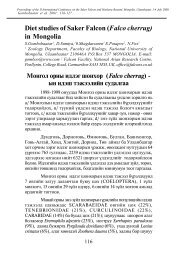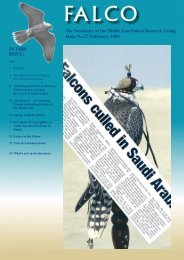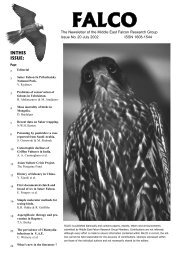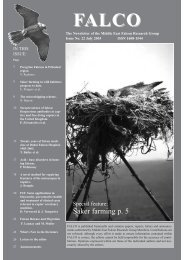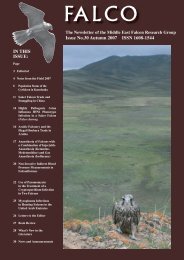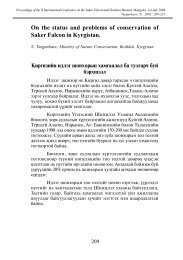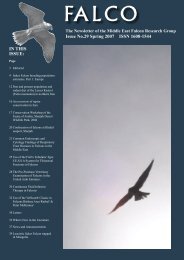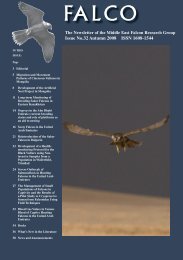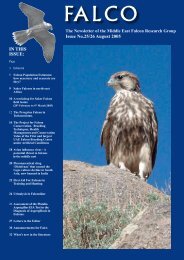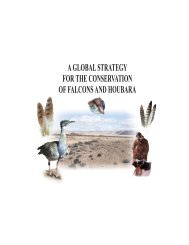Falco cherrug - International Wildlife Consultants Ltd.
Falco cherrug - International Wildlife Consultants Ltd.
Falco cherrug - International Wildlife Consultants Ltd.
You also want an ePaper? Increase the reach of your titles
YUMPU automatically turns print PDFs into web optimized ePapers that Google loves.
Table 1. Numbers of Sakers in administrative districts of Russia.<br />
¹ Region Area, km 2 territories (pairs)<br />
per 1000 km 2) Trend<br />
Known breeding Estimated numbers Density (pairs<br />
1 Saratov District 101258 0 5 (0-10) 0.5 -2<br />
2 Samara District 53579 2 4 (0-6) 0.7 -2<br />
3 Republic of Tatarstan 48056 0 1 (0-2) 0.2 -2<br />
4 Orenburg District 124606 12 26 (20-31) 2.1 -1<br />
5 Bashkortostan Republic 74764 8 10 1.3 1<br />
6 Chelyabinsk District 66015 7 20 (18-22) 3 1<br />
7 Kurgan District 71692 7 65 (56-75) 9.1 0<br />
8 Tumen’ District 28064 0 4 (3-5) 1.4 0<br />
9 Omsk District 34616 0 11 (5-16) 3.2 0<br />
10 Novosibirsk District 21706 0 2 (1-3) 0.9 0<br />
11 Altay Krai 140128 38 111 (99-140) 7.9 0<br />
12 Kemerovo District 6928 0 6 (3-9) 8.7 -1<br />
13 Altay Republic 76289 34 465 (310-610) 61 -1<br />
14 Khakassia Republis 44291 21 190 (180-200) 42.9 -1<br />
15 Krasnoyarsk Kray 65201 12 56 (40-70) 8.6 -1<br />
16 Tuva Republic 126841 230 1130 (1070-1216) 89.1 -1<br />
Total 1084035 371 2106 (1815-2425) 19.4 -1<br />
5<br />
the Saker was breeding along the Ursul river, at the<br />
Seminchkiy range and was noted close to Shebalino village<br />
(Kuchin 1976). In the Altay Nature Reserve the Saker was<br />
reported at the Kayru river, at the sources of Chulchi river,<br />
in the Abakan Range at the sources of Erinat river and at the<br />
Shavla river near the sources of Kalbak-Kai creek<br />
(Folitarek, Dementiev 1938, Stakheev et al. 1982, Irisova<br />
and Irisov 1990). In the northern Altay the Saker was<br />
observed at the beginning of the 20 th Century between Anos<br />
and Miyuta vllages (Ruzskiy 1915), however by the end of<br />
the 20 th Century it was no longer in evidence (Tsibulin<br />
1999). A.P. Kuchin (1976) considered the Saker as a rare<br />
species of the central and south-eastern Altay, but noted that<br />
the species was more common at the sources of the Ob river,<br />
especially at the Biya-Chumish highlands (now a territory<br />
of the Altay Kray). In 1965-72 he observed 6 nests in a pine<br />
grove near Biysk town, between the Biya and Katun’ rivers,<br />
at the Subenka and Ursul rivers, and at Elo village.<br />
In the Altay Kray (not be mistaken with the Altay<br />
Republic) the majority of Saker sightings during the breeding<br />
season were reported from the forest patches and pine<br />
forest strips of the Kulunda steppe and the Ob plateau<br />
(Petrov et al. 1992, Plotnikov 1992, Kuchin and Kuchina<br />
1995, Petrov 1995, Petrov and Irisov 1995). However some<br />
reports from the Altay foothills (Malkov 1998). V. N.<br />
Plotnikov (Malkov 1998) expressed the opinion that in the<br />
1990s the total number of Sakers in the Altay Kray was 300<br />
individuals (including 70 breeding pairs). In the Kurgan<br />
District the Saker was always considered at the limit of its<br />
range, and up to now there were no confirmed breeding<br />
observations in this region, although it is considered that it<br />
has spread up to the Sverdlovsk and Tumen’ regions<br />
(Sabaneev 1874, Larionov 1926). On 19 June 2002 a pair of<br />
non-breeding Sakers was observed at Gorkoe lake<br />
(Ryabitsev et al. 2002) – this is the only published record of<br />
a Saker in the Kurgan District. T.K Blinova and V.N.Blinov<br />
(1997) observed a single Saker in the Tobol valley at<br />
Vedenyatsoye Lake, Tumen’ District on 22 July 1982, i.e.<br />
after the breeding season. This latter observation is the<br />
northern-most record of the Saker. Yu. S. Ravkin and coauthors<br />
(1988) stated that the numbers of Sakers in the<br />
Western-Siberian Plane at the end of 1980s was 1000 individuals.<br />
According to researchers of 19-20 th Centuries, the<br />
Saker in the Volga-Ural Region was not rare on steppe and<br />
forest-steppes with a maximum density on the foreststeppes<br />
of the pre-Volga highlands, the High Volga (Na<br />
Gorakh) and the southern Urals (Eversmann 1866,<br />
Bogdanov 1871, Ruzskiy 1893, Zarudniy 1888, Sushkin<br />
1897, Karamsin 1901, Zhitkov and Buturlin 1906, Kirikov<br />
1952). It appears that the most significant enclave of breeding<br />
Sakers was within the territory of the Upper Zavolzhye,<br />
where, according to Karamzin (1901) the Saker was at a<br />
breeding density of 3-4 pairs per 100 desyatin (=1.09252<br />
km 2 ). The north edge of the range is limited by the Alatyr<br />
river, the Kama confluence with the Volga, and the Belaya<br />
river in the Urals (Grigoriev et al. 1977). However in the<br />
beginning of 1980s it was not found to be breeding in<br />
Bashkiria or Tataria (Gorshkov et al. 1983, Ilichev and<br />
Fomin 1988), and only a few pairs were found in the<br />
Orenburg District (Davygora 1988).<br />
Geography of breeding and numbers<br />
As for the year 2003, we have located 371 Saker<br />
breeding territories in the region under review. In addition<br />
we know of 1 breeding territory in the Burtinskaya Steppe<br />
of the Orenburg Nature Reserve (Chibilev et al. 1996), 3<br />
breeding territories at the south of the Saratov District<br />
(Zavialov and Ruban 2001), and 5 breeding territories in the<br />
Sayano-Shushenskiy Nature Reserve (Stakheev et al. 1999).



